
by logisticsplus | Jan 11, 2022 | News


The Covid-19 pandemic has affected all parts of the global logistics industry. From the way we source raw materials to how final deliveries are made, the industry has changed forever. With an increasingly globalized world, the demand for logistics services is at an all-time high. Each year, the logistics industry undergoes significant change. As the world continues to move forward, it is crucial to stay ahead of trends and innovations that will shape the future of logistics. Let’s look at some of the top global logistics trends to expect in 2022.
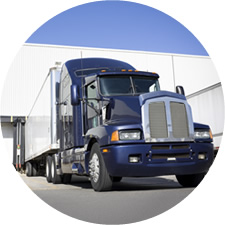 Last-Mile Delivery Services
Last-Mile Delivery Services
The pandemic provided a significant spark to the already growing e-commerce industry. As consumer behavior changed and online shopping increased, parcel delivery demand surged. Customers want their orders quickly, and they want to know exactly where their order is every step of the way. Last-mile (sometimes called final-mile) delivery is a term used to describe the last leg of delivering goods from a warehouse to the end customer. Logistics companies must heavily invest in tracking and route optimization tools to increase efficiency to keep up with this trend. Even after the pandemic passes us, e-commerce will never go away.
 Supply Chain Visibility
Supply Chain Visibility
According to Forbes, more than 90% of supply chain executives said that supply chain visibility is a key to their success. Although this isn’t a new trend for 2022, it becomes more vital each year. In addition to identifying trends early to prevent issues, visibility is required to provide good customer service. Predictive analytics, custom reporting, interactive dashboards, and control tower capabilities are all ways to increase supply chain visibility.
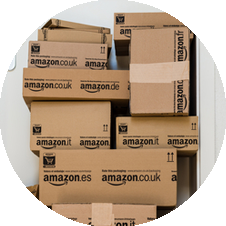 Focus on Returns Management
Focus on Returns Management
With the number of online orders increasing, it only makes sense that returns are also growing. When searching for a logistics partner, e-commerce sellers want a reliable and straightforward returns process. To provide a positive customer experience, a logistics provider must handle returns in large numbers, provide inventory management, and integrate with e-commerce platforms to process returns. Many companies will adopt new technology that streamlines this process to run returns management as efficiently as possible.
 Conversion to Cloud-Based Systems
Conversion to Cloud-Based Systems
Cloud-based computing provides an upper hand when it comes to total logistics management. Although there are many effective cloud-based solutions in place, 2022 is expected to bring even more. Logistics companies can facilitate scalability, improve reliability, and increase security by utilizing cloud-based systems. For global logistics companies with users worldwide, a cloud-based system can help enhance back-office operations due to the collaboration and accessibility features it offers.
 Autonomous Trucking Research & Development
Autonomous Trucking Research & Development
While self-driving trucks may not hit the road in 2022, look for transportation companies to continue to invest in autonomous vehicle research. According to PitchBook, in the first half of 2021, investors put a record $5.6 billion into companies developing autonomous driving technologies. Logistics companies view autonomous trucking as a massive opportunity to reduce costs and increase efficiency. Even though it’s hard for trucking companies to keep up with demand, autonomous trucking can help alleviate the concern over driver shortages.
 Staff Recruiting & Retention
Staff Recruiting & Retention
In a tight labor market, it’s become challenging to find the necessary talent required to run logistics operations smoothly. This results in a lack of resources, postponed deliveries, strained relationships with partners and suppliers, and other challenges. The labor market shortage extends well past the logistics industry. The shortage has led many retailers to discover the value of a logistics partner that can take over cumbersome responsibilities such as storing, picking, packing, and other headaches. Addressing staff recruitment and retention is one of the global logistics trends to stay for the foreseeable future.
 Sustainable Logistics Practices
Sustainable Logistics Practices
Another notable trend in the global logistics industry is the advancement of sustainable logistics practices. In addition to benefitting us and our planet, it’s cost-effective, promotes a good brand, and increases customer loyalty. Most reputable logistics companies join sustainability partnerships and organizations that encourage cleaner fuel, more efficient equipment, and lower emissions. As we shift to 2022, look for even more businesses to lower their carbon footprint to align with this sustainability trend.
The future of the global logistics industry is constantly evolving. Over the past two years, we’ve learned that supply chain disruptions are inevitable, and you must plan ahead. As e-commerce continues to explode and new challenges arise, 2022 will be another year of advancements and innovations shaping the logistics industry.

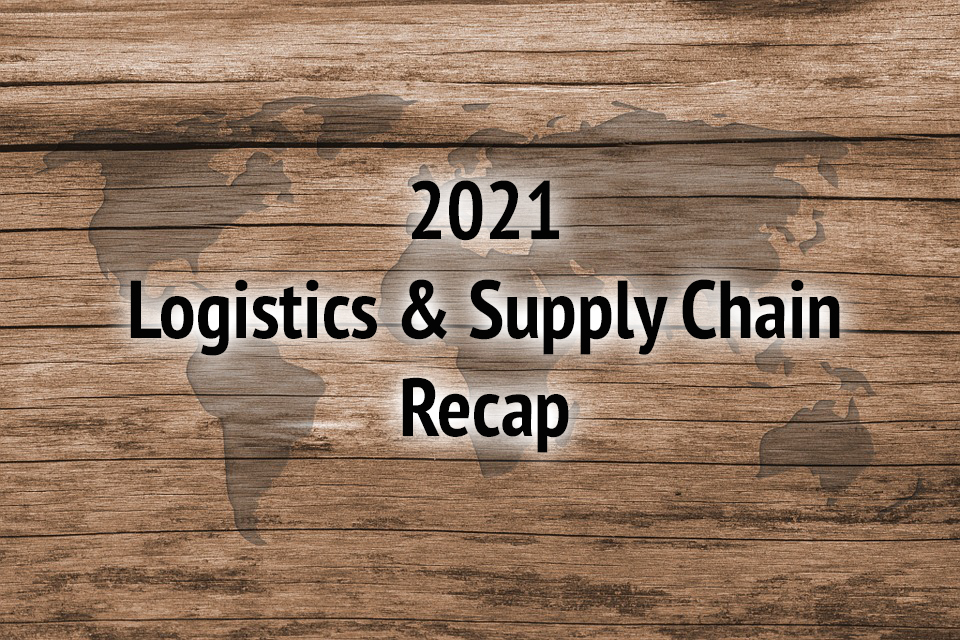
by logisticsplus | Jan 7, 2022 | News
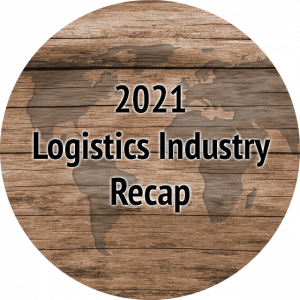 Covid-19 and a global shutdown left the world ready to put 2020 behind us. Little did we know, 2021 would take us for another wild ride. As the pandemic lingered and gained strength in unexpected places, it continued to interrupt supply chains worldwide. Production bottlenecks, volatile swings in pricing, and massive capacity shortages were just a few of the issues that shaped the logistics and supply chain industry landscape in 2021. In this article, we look back at some of 2021’s supply chain issues and highlight some of the industry trends to look for in 2022.
Covid-19 and a global shutdown left the world ready to put 2020 behind us. Little did we know, 2021 would take us for another wild ride. As the pandemic lingered and gained strength in unexpected places, it continued to interrupt supply chains worldwide. Production bottlenecks, volatile swings in pricing, and massive capacity shortages were just a few of the issues that shaped the logistics and supply chain industry landscape in 2021. In this article, we look back at some of 2021’s supply chain issues and highlight some of the industry trends to look for in 2022.
The World Learned The Importance Of Supply Chains
A few years ago, your average person might not have been able to explain what “supply chains” are. Now, it feels like every time you turn on the news, that’s one of the topics you hear. A global shortage of materials caused prices to soar and projects delayed. Ports are congested, labor shortages in trucking have caused delays, a lack of warehouse capacity, and the list goes on. So much disruption happened in 2021 that you may have forgotten about the Suez Canal disaster. For just one year, that’s a lot to process.
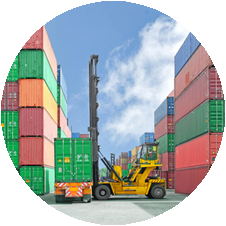 Port Congestion Causing Severe Delays
Port Congestion Causing Severe Delays
As dockworkers contracted Covid-19 or landed in quarantine, loading and unloading at ports are constrained. The pandemic has sidelined truck drivers, limiting the availability of vehicles that can carry products from ports to warehouses to customers. Throughout the pandemic, consumers are purchasing goods rather than services. According to Bloomberg, retail imports set a record high for the United States in 2021. To understand just how clogged the ports were, the average wait at anchor (i.e., the number of days cargo ships waited outside the port) peaked at 20.9 days for the port of Los Angeles. In late December, there were 102 cargo vessels anchored in San Pedro Bay.
A Volatile Pricing Market
International shipping rates hit all-time highs in 2021. Ocean rates increased due to non-stop demand for ocean freight from Asia to the United States and a lack of capacity. Demand and congestion are the main drivers for sustained sky-high rates. To put the situation in perspective, international freight rates in August 2021 reached $10,174/FEU, a 466% increase on the previous year. Experts predict that prices may take two years to return to normal levels based on past market cycles.
Domestic Trucking Shortage
The American Trucking Associations estimated that in 2021 the truck driver shortage would reach over 80,000 drivers. There isn’t a single cause of the driver shortage. Still, a few factors that contribute to the problem are the high average age of current drivers (increased number of retirements), women making up only 7% of all drivers (well below the workforce average), and lifestyle issues such as the time away from home. Although driver pay and earnings have gone up significantly in the past decade, the problem of recruiting new drivers to the industry remains.
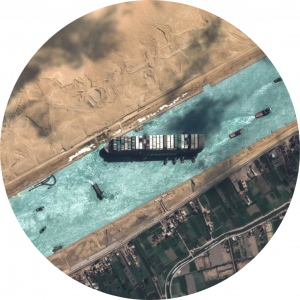 The Suez Canal Blockage
The Suez Canal Blockage
Although it felt like years ago, the Suez Canal debacle happened in 2021. Since its completion in 1869, the Suez Canal has become one of the world’s most essential seaways. This human-made waterway enables a more direct route for shipping between Europe and Asia. According to Reuters, about 12% of the world’s shipping traffic moves through the canal, so the blockage disrupted an estimated $10 billion worth of goods each day.
Natural Disasters Impacting Supply Chains
As if the world needed more supply chain disruptions, 2021 presented challenges out of our control. Hurricane Ida, the Texas winter storm, California wildfires, and significant flooding in Canada are just a few of the events that rattled supply chains across the globe. Hurricane Ida caused destruction and fuel shortages. The winter storm in Texas caused power outages and shipping delays. The California wildfires caused road closures. The floods in Canada caused railway and road damages. The point is, the logistics and supply chain industry had a wild ride in 2021.
Policy Responses
In 2021, the Joe Biden administration introduced proposals to address the ongoing supply chain disruptions. In June, the administration announced a supply-chain “disruptions task force” that created an agreement to operate the Port of Los Angeles 24/7. The task force enlisted freight companies to help move goods off the docks. Furthermore, the Transportation Department provided a $5 billion loan to modernize California ports. Later in the year, the President announced the Bipartisan Infrastructure Investment and Jobs Act. This $550 billion federal investment for America’s roads, bridges, water infrastructure, and more is the largest federal investment in public transit ever.
What To Look For In 2022
There is no indication that supply chain disruptions will ease up in 2022. Bottlenecks, labor shortages, and capacity crunches remain widespread as we begin the year. While nobody can predict precisely when supply chains will normalize, we can predict how shippers will adapt in 2022. Given that supply chains will continue to be stressed, companies must deploy real-time visibility platforms to monitor shipments at the order level. Having end-to-end supply chain visibility and advanced information on lead-time changes can only help navigate these challenging issues.
Understanding that supply chain disruptions are inevitable means that you must plan ahead. 2022 isn’t the year to wait and see if supply chains normalize. By embracing new trends and technologies, companies can minimize these disruptions’ impact on their business.


by logisticsplus | Nov 16, 2021 | News
 Anyone involved in domestic transportation now knows all too well that freight rates have been skyrocketing to historic levels. According to Transportation and Warehousing produce price indices tracked by the U.S. Federal Reserve, year-over-year industry-wide less-than-truckload prices have risen between 8-14% in recent months, and full truckload prices have risen between 20-30% (and diesel fuel prices are up 27% on top of that).
Anyone involved in domestic transportation now knows all too well that freight rates have been skyrocketing to historic levels. According to Transportation and Warehousing produce price indices tracked by the U.S. Federal Reserve, year-over-year industry-wide less-than-truckload prices have risen between 8-14% in recent months, and full truckload prices have risen between 20-30% (and diesel fuel prices are up 27% on top of that).
The message is clear, reducing overall supply chain costs right now will be a significant challenge. In fact, in the 30th Annual Study of Logistics and Transportation Trends published in the September 2021 issue of Logistics Management, only 8.2% of shippers surveyed feel that reducing costs is a primary objective right now. That compares with 21.8% in 2020 and 29.8% in 2019. What are the new primary objectives? 20.5% say maximizing asset utilization, 35.6% say increasing customer satisfaction, and 35.6% say maximizing profitability are all now higher primary objectives.

(Click to Enlarge)
So how can shippers try to offset these rate increases as they look to maximize profitability over the coming months and year? Here are some tips from your friends at Logistics Plus:
- Ship larger shipments less often. Even with truckload rates at all-time highs, a larger load of the product will generally ship more cost-effectively than multiple smaller loads.
- Minimize the cubic footprint of shipments (i.e., smaller, denser) to avoid overlength, minimum cubic capacity, and capacity load charges assessed by some carriers.
- Consolidate orders where possible to reduce unnecessary freight charges (the Logistics Plus Business Intelligence department can review your historical data to see about potential recommendations).
- Utilize the Logistics Plus North American Division (NAD) to help spot quote some of your larger shipments. Sometimes shipments over five pallets or 5,000 pounds (as a guideline) can be spot quoted for less money if it moves in a desirable backhaul lane for a carrier.
- Utilize regional warehousing to optimize/balance inventory to be as close to final customers as possible (Logistics Plus has multiple warehouses located across the United States).
- Improve BOL accuracy to minimize re-weigh, re-class, and inspection fees (carriers are getting punitive on inaccurate bills of lading).
- Improve order accuracy to minimize re-consignments and re-deliveries (don’t ship a shipment any more than you have to).
- Consider implementing a “prepaid and add” program (if you haven’t already) to mark up your freight costs by X% and pass that on to your customers/vendors to help offset your freight costs.
- Implement a freight invoice consolidation, auditing, and payment program to gain further visibility and insights into your freight spend and maximize recovery of refundable monies (e.g., guaranteed failures, orders paid but not tendered, address corrections, etc.).
Want to explore these and other ideas? Contact Logistics Plus, and let’s talk.

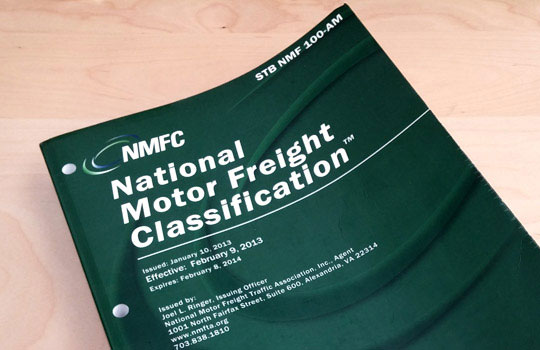
by logisticsplus | Oct 14, 2021 | News
 The Commodity Classifications Standards Board (CCSB) has published a new supplement to the National Motor Freight Classification (NMFC®). These NMFC changes are effective 12/04/2021. Some notable changes are listed below.
The Commodity Classifications Standards Board (CCSB) has published a new supplement to the National Motor Freight Classification (NMFC®). These NMFC changes are effective 12/04/2021. Some notable changes are listed below.
Subject 1 – Foodstuffs, Item 73227 canceled and replaced by 72310, 73260, and 73365.
Subject 2 – Dehydrated Cheese New Item 55450, revised Item 55470 – Cheese food, and Item 73260 – Snack Foods
Subject 3 – Box Group. Items 29080 and 29110, 29140 and 29780, 29800, 29805, 29810, 112360 and Canceled and replaced with Item 29785 or 112870 ( 29785 – Boxes or Cartons, fiberboard or paperboard, NOI., 112870 – Lumber NOI, or Wood, built-up or combined, or Plywood, NOI)
Subject 4 – Item 101720 Ink and related materials
Subject 5 – Faucets
Subject 6 – Toilet or Bidet Seats
Subject 7 – Boxes, Chests or Cabinets, Tool, Ammunition or Fishing Tackle
Subject 8 – Mixing Machines (Asphalt, cement, concrete or mortar)
Subject 9 – Item 59380 – Solutions or Sterile Water, intravenous
Subject 10 – Item 680 – Packing or Packaging – General
Subject 11 – Item 682 – Pictorial Precautionary Markings
Subject 12 – Item 689 – requirements and Conditions for Test Shipments, CANCELED, obsolete
Subject 13 – Withdrawn to continue research (Item 39510 – Cables)
Subject 14 – Charcoal, Charcoal Briquettes or Charcoal Pellets
Subject – 15 – Broilers, Grills, Roasters or Stoves, cooking, outdoor type, electric
Subject 16 – Manifolds, gas, furnace, stove, or heater
Subject 17 – Kits, pregnancy test – New Item 56975 replaces 59793
Subject 18 – Cord, Cordage, Rope, other than wire rope, String or Twine, NOI,
Subject 19 – Washers; Gaskets; or Packing Devices, Forms or Shapes
Subject 20 – Withdrawn to Continue Research – Cookware, cast iron, NOI
Subject 21 – Wood Chips or Wood Chunks,
Subject 22 – 186080 Sod Cutters, etc – Canceled and replaced by Items 130207 and 186620
Subject 23 – ITEM 292 – SPECIFICATIONS FOR FIBER PAILS
Subject 24 – 100800 Dispensers, tea or ground coffee, household – Canceled
Subject 25 – 122000 Grading or Road Making Attachments or Implements, or Parts thereof
Subject 26 – 10920 Fenders, 21470 Baptistries, 164390 Racks and Related Articles – Packaging exceptions changed
Subject 27 – Various items – Reference to Package 2039 would be removed from item 24080, as it would not provide sufficient protection in today’s less-thantruckload environment. Concurrently, other changes are proposed for clarification and Simplification.
Subject 28 – Various Items – Simplifies the minimum packaging requirements in the involved items to require “in bags” in lieu of the specific types currently named. Other changes to the minimum packaging requirements are proposed for clarification and simplification.
Subject 29 – Various Items – simplify the minimum packaging requirements in the involved items to require “in bags” in lieu of the specific types currently named. Other changes to the minimum packaging requirements are proposed for clarification and simplification.
Subject 30 – Various Items – Cancels items 46170, 46180, 46190, 46570, 46670 and 46700 with reference to item 44155, items 46540 and 46640 with reference to item 44515, items 46160 and 46460 with reference to item 45467, and item 46300 with reference to item 45615. These changes are proposed to provide classes reflective of the respective hazards of, and regulations applicable to, the involved materials. The changes are also in the interest of clarification, simplification and uniformity. Since item 46170 is the only item that authorizes Package 355, the package would be concurrently canceled as having no further application. This proposal would also add the term “Baking Soda” to the listing in item 46220 for Sodium Bicarbonate in the interest of clarification.
Subject 31 – Cancels items 42870, 42920, 43180 and 43230 with reference to item 44155, items 43170 and 45460 with reference to item 44500, and items 43080, 43260 and 43290 with reference to item 45615. These changes are proposed to provide classes reflective of the respective hazards of, and regulations applicable to, the involved materials. The changes are also in the interest of clarification, simplification and uniformity. Note, item 45462 would be canceled as having no further application.
Subject 32 – Cancel item 91220 with reference to items 44500, 44515 and 64300, as applicable. In addition to providing clarification, simplification and uniformity, this change would assign classes reflective of the respective hazards of and regulations applicable to box toe gum.
Subject 33 – Amends the provisions of item 42652 to remove the “bomb burst” symbol (), add language further restricting the item’s application to materials not required by the DOT to bear a Hazard Class or Hazard Division label or placard, and refer to a new attendant Note clarifying that item 42652 does not apply on materials regulated by the DOT as hazardous and required to bear a Hazard Class or Hazard Division label or placard. The proposed new Note would direct the Classification user to other items for classes applicable to such hazardous materials.
Subject 34 – Amend the provisions of item 171410 to remove the “bomb burst” symbol (), add language further restricting the item’s application to materials not required by the DOT to bear a Hazard Class or Hazard Division label or placard, and maintain class 70, per the present sub 2 provisions of the item. A new attendant Note would be established to clarify the item’s intent and would direct the Classification user to other items for classes applicable to such hazardous materials.
Subject 35 – The following numbered packages are canceled and reference(s) to them in individual item descriptions are removed:
- 759
- 762
- 773
- 776
- 788
- 789
- 794
- 795
- 801
- 802
- 814
- 818
- 934
- 1306
- 2332
- 2387
Subject 36 – The following numbered packages are canceled and reference(s) to them in individual item descriptions are removed:
- 825
- 826
- 827
- 834
- 838
- 841
- 846
- 868
- 870
- 881
- 886
- 911
- 919
- 932
- 978
- 1029
- 2304
- 2305
- 2413
- 2529
Subject 37 – The following items are canceled as obsolete:
- 81370
- 83740
- 87590
- 87630
- 88540
- 89710
- 89990
- 90970
- 91120
- 91140
- 91200
- 91280
- 91400
- 91440
Subject 38 – The following items are canceled as obsolete:
110120
- 110160
- 110270
- 110290
- 110497
- 112980
- 115720
- 115880
- 116400
- 116670
- 116730
- 131310
- 131620
- 134100
- 134220
- 134280
- 134300
- 134570
- 135620
- 135660
Subject 39 – The following items are canceled as obsolete:
- 117200
- 117240
- 117360
- 118220
- 119060
- 125540
- 125600
- 125640
- 125660
- 126040
- 126120
- 127760
Subject 40 – The following items are canceled as obsolete:
- 98870
- 99190
- 99200
- 99210
- 99230
- 99250
- 99320


by logisticsplus | Jul 14, 2021 | News
 The Commodity Classifications Standards Board (CCSB) has published a new supplement to the National Motor Freight Classification (NMFC®). These NMFC changes are effective 08/07/2021. Some notable changes are listed below.
The Commodity Classifications Standards Board (CCSB) has published a new supplement to the National Motor Freight Classification (NMFC®). These NMFC changes are effective 08/07/2021. Some notable changes are listed below.
Machinery or Machines, NOI, or Machinery or Machine Parts, NOI
- Density breaks have been added at 5, 10 and 15 PCF for item 133300.
- Item 133300 is now a 8 scale density item instead of a 6 scale density item.
Cereals
- New Item 72310 was created for Cereals, NOI and will have 3 classes predicated on density breaks at 8 and 12 PCF.
- Items 42300 (Cereal Group), 42310 (Cereals), 42315 (Cereals, NOI, in boxes), 42318 (Cereals, Infant), 42320 (Cereals, Cooked), 42330 Bran, Bran and Wheat Combined), 42350 (Combination Packs), 42380 (Granola), 42390 (Granulated), 42410 (Popped or Puffed) and 42436 (Wheat) are canceled with reference to new item 72310 (Cereals, viz).
Charcoal, coconut shell, nut shell, NOI, or fruit pit, not activated
- Item 42450 is amended to a two tier class structure based on packaging (Class 85 and Class 65).
- The bomb burst symbol has been removed and now is only applicable when not regulated by the U.S. DOT for placarding.
Flag Poles, Staffs or Sticks, or Sections thereof, including Flag Pole, Staff or Stick Bases or Stands
- New Item 160420 was created for Poles, Staffs, or Sticks, flag, or Sections thereof, NOI, with or without baes, holders or stands; or Flag Pole, Staff or Stick Bases. Holders or Stands with classes are predicated on greatest dimension and density, with breaks at 6 and 12 PCF.
- Items 22060 (Bases), 69990 (Flag Poles, Staffs or Sticks, or Sections thereof), 70000 (Flag Poles, Staffs or Sticks, or Sections thereof), 70010 (Flag Poles, Staffs or Sticks, or Sections thereof), 94880 (Flag Holders or Stands, iron) are canceled with reference to new item 160420.
Shields, Guards or Flaps, mud or fender, automobile
- Item 19480 (Shields, Guards or Flaps) is canceled with reference to item 18260 (Body Parts; Parts; or Trim).
Chemicals Oxygen Generators
- New Item 45470 was created for Oxygen Generators with classes based on density with density breaks at 4 and 8 PCF.
- Item 43865 (Candles) is canceled with reference to new item 45470 (Oxygen Generators).
Spools
- New Item 177400 was created for Spools, NOI with classes based on the 11 sub full scale density scale.
- Items 177450 (Aluminum, wire shipping, used), 177470 (Aluminum, NOI), 177500 (Brass, Bronze, or nickel-silver), 177520 (Chemically hardened fiber and pulpboard, wood or metal combined), 177540 (Chemically paper or pulpboard, or chemically hardened paper or pulpboard and wood combined), 177560 (Compressed ground wood or fiberboard wallboard heads (ends) and fiberboard drums), 177580 (Iron, Steel or wooden, or iron or steel and wood combined, assembled or not assembled), 177600 (Magnesium, or Magnesium alloy, cast, rubber thread shipping), 177620 Paper or pulpboard, NOI) and 177640 (Rubber composition or wood and rubber composition combined) are canceled with reference to new item 177400 (Spools, NOI).
Gratings or Foot Walks, aluminum
- New Item 13450 was created for Footwalks, Walkways or Grating with classes predicated on greatest dimension and density, with breaks at 9 and 12 PCF.
- Item 13490 (Gratings or Foot Walks) is canceled with reference to item 13450 (Footwalks, Walkways or Gratings).
Miscellaneous Hazardous Materials – Hazard Class 9, and infectious Substances- Hazard Class 6, Hazard Division 6.2
- A new item, Item 45322, has been established for Miscellaneous Hazardous Materials, NOI, including Environmentally Hazardous Substances, NOI, or Other Regulated Substances, NOI.
- The class is predicated on density breaks at 20 and 30 PCF.
Patient Care, Comfort or Treatment Kits or Sets
- Item 56790 (Kits) is canceled with reference to item 56785 (Kits or Sets, patient care, comfort or treatment).
- Item 56785 is a full scale density item.
Bulbs or Tubers
- Item 71130 (Bulbs or Tubers) is canceled with reference to item 71120 (Bulbs or Tubers, NOI).
- Item 71120 is amended to provide classes predicated on packaging and density, with breaks at 9 and 15 PCF.
Brick, building or paving, or Firebrick
- Item 32100 (Brick) is amended to provide classes predicated on a density break at 30 PCF.
Artists’ or Crafters’ Material or Supplies
- New Item 14535 was created for Artists’ or Crafters’ Materials or Supplies with classes based on the 11 sub full scale density scale.
- Items 14530 (Artist’s Board), 14540 (Artists’ Materials and Paints) and 14560 (Kits, craft, NOI) are canceled with reference to 14535 (Artists’ or Crafters’ Materials or Supplies viz).
Halogenated Monomethyldiphenyl-Methanes, Polychlorinated Biphenyls (PCBs), or Polyhalogenated Biphenyls or Polyhalogenated Terphenyls
- This item is no longer approved for use in the United States but can be manufactured in the United States for export to other countries.
- Class 500 will apply if inadvertently accepted.
Disposable Clothing and Related Articles
- Item 56710 (Drapes, Sheets, Pillowcases, Towels, Washclothes or Patient Examination Gowns) is canceled with reference to item 56545 (Clothing and Related Articles).
- Item 56545 (Clothing and Related Articles) is amended to provide classes based on density breaks at 6 and 10 pcf.
Belts, abrasive
- Item 1060 (Belts, abrasive) is amended to a full scale density item.
Refrigeration Units (reefer Units), truck, trailer or marine container
- Item 123600 has been amended to provide classes predicated on greatest dimension and density, with breaks at 8 and 15 PCF.
Seats, bathtub or shower
- Item 172680 (Seats, bathtub, baby, nested) is canceled with reference to item 159000 (Seats, bathtub or shower, including Baby bath Seats).
- Item 159000 is amended from class 77.5 to class 150.
Butchers’ Block (Butcher Blocks); or Butchers’ Cutting or Chopping Tables or Table Tops
- New Item 39120 was created for Butchers’ Blocks (Butcher Blocks); or Butchers’ Cutting or Chopping Tables or Table Tops with classes predicated on greatest dimension and density, with a single density break at 12 PCF.
- Item 24120 (Blocks, butchers; Cutting or Chopping Tables; or Butchers’ Cutting or Chopping Table Tops) is canceled with reference to item 39120 (Butchers’ Blocks (Butcher Blocks); or Butchers’ Cutting or Chopping Tables or Table Tops).
Chemicals (Specific Provisions for Commodities regulated as Hazardous Materials)
- Items 44950 (Sulfate, crude), 44960 (Sulfate, refined) 44690 (Bromide) and 47110 (Tin Bichloride) are canceled with reference to item 44155 (Corrosive Materials).
- Items 44855 (Isobutyric Anhydride), 45260 (Methyl Acetone), 46023 (Pyroligneous Acid), and 46850 (Cumene) are canceled with reference to item 44500 (Flammable Liquids, NOI; or Combustible Liquids).
- Items 44910 (Peroxide, ground, dry), 44920 (Peroxide, paste), 46270 (Chromate), 46480 (Perborate), and 47100 (Thorium Nitrate) are canceled with reference to item 45467 (Oxidizers, NOI).
- Items 45960 (Potassium-Xanthate) and 46690 (Sodium-Xanthate) are canceled with reference to item 44515 (Flammable Solid, Spontaneously Combustible or Dangerous When Wet Materials).
- Items 45325 (Monochloroacetic Acid), 45900 (Silicofluoride), 46530 (Prussiate), 46870 (Dinitrochlorobenzene (Dinitrochlorobenzol)), 46890 (Dinitrotoluol, dry), 46930 (Mononitrotoluol) and 46970 (Orthodichlorobenzol) are canceled with reference to 45615 (Poisonous or Toxic Materials).
The below rules have been updated and clarified.
Item (Rule) 250- Definition of or Specification for Cylinders
- Packaging specifications for cylinders is amended to ensure it can withstand the LTL environment.
Item (Rule) 680- Freight that Must be Floor-Loaded
- Section 17 has been added.
Item (Rule) 220- Definition of or Specification for Boxes
- Notes 3 and 4 are canceled.
Item (Rule) 235- Specifications for Bundles, Coils, Reels or Rolls
- This item has been amended by adding “Except where more specifically provided in individual items,”
Item (rule) 240- Specifications for Carboys
- Packaging specifications for cylinders is amended to ensure it can withstand the LTL environment.
The following items are canceled as obsolete:
39710 Outfits, amateur retouching
40340 Gelatine
40380 Paper and Tin Ring
40610 Clinker
40960 Cans, cream or milk shipping
40970 Cans, ice cream, fiberboard, insulated
40980 Cans, oyster shipping, iron
42500 Checks, baggage or parcel
43510 Blasting Chlorate, NOI
48375 Ore, actinolite
48383 Ore, beryllium
50020 Color, butter
50023 Color, cheese
50395 Compounds, wood splitting preventive
54230 Unginned (Cotton in the Seed)
54670 Match Book, not cut to specific size, printed
55060 Shot
55500 Concentrated Sweet Cream
55510 Egg Albumen Concentrate
55895 Christmas Trees, natural, preserved, flocked or not flocked, mounted on stands
55905 Christmas Trees, with wooden trunks and flock coated metal branches
56210 Ruscus or Eryanthus
57580 Doubletrees, Eveners, Neckyokes or Singletrees
57900 Hydrobarometers
58960 Malt Tonics
62725 Platters, phonograph turntable
62740 Racks, mine lamp charging
64460 Sumac
65660 Pails, fruit gathering, iron, with cloth bottoms
65780 Seed Corn Driers
65800 Silo Door Frames
67940 Felt or Felt Wheels
67960 Felt, gun wad
67970 Felt, hair, not woven
68660 Fiberware
68960 Filling, sisal
69790 Fish Roe, fresh
69930 Fish Livers, salted or chemically preserved
69980 Fish Scrap
71240 Lily of the Valley Roots (Pips)
71840 Foliage or Leaves
72460 Citrons or Lemons

Page 3 of 12«12345...10...»Last »


![]()
 Last-Mile Delivery Services
Last-Mile Delivery Services Supply Chain Visibility
Supply Chain Visibility Focus on Returns Management
Focus on Returns Management Conversion to Cloud-Based Systems
Conversion to Cloud-Based Systems Autonomous Trucking Research & Development
Autonomous Trucking Research & Development Staff Recruiting & Retention
Staff Recruiting & Retention Sustainable Logistics Practices
Sustainable Logistics Practices


 Covid-19 and a global shutdown left the world ready to put 2020 behind us. Little did we know, 2021 would take us for another wild ride. As the pandemic lingered and gained strength in unexpected places, it continued to interrupt supply chains worldwide. Production bottlenecks, volatile swings in pricing, and massive capacity shortages were just a few of the issues that shaped the logistics and supply chain industry landscape in 2021. In this article, we look back at some of 2021’s supply chain issues and highlight some of the industry trends to look for in 2022.
Covid-19 and a global shutdown left the world ready to put 2020 behind us. Little did we know, 2021 would take us for another wild ride. As the pandemic lingered and gained strength in unexpected places, it continued to interrupt supply chains worldwide. Production bottlenecks, volatile swings in pricing, and massive capacity shortages were just a few of the issues that shaped the logistics and supply chain industry landscape in 2021. In this article, we look back at some of 2021’s supply chain issues and highlight some of the industry trends to look for in 2022. Port Congestion Causing Severe Delays
Port Congestion Causing Severe Delays The Suez Canal Blockage
The Suez Canal Blockage


